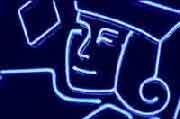Tuesday, June 10, 2008
ChartwellWatch out for the trademark cigars all over the house, and several framed examples of Winston's finer brushwork. Look, even the wartime Prime Minister had his own ration book. And there's his Nobel Prize for Literature, and his certificate of honorary American citizenship, and blimey Churchill was a bit of a superman really, wasn't he? Right man, right place, right time. Having visited Chartwell I can now also picture him as a family man, sat at the circular table in his low-ceilinged dining room, gazing out through the arched windows at the Westerham hills. Who wouldn't have been happy here [photo]?
Location: Mapleton Road, Westerham, Kent TN16 1PS [map]
Open: 11am - 5pm (closed Mondays & non-summer Tuesdays) (closed Nov-Feb)
Admission: £11-ish (or free to National Trust types)
3-word summary: Churchill's Wealden homestead
Website: www.nationaltrust.org.uk
Time to set aside: half a day
1922 wasn't Winston Churchill's finest hour. He lost his seat in Parliament after a distinguished political career and suddenly found himself with plenty of time on his hands. The perfect year, then, to snap up a Victorian country manor house in the Kentish hills near Westerham. Chartwell Manor cost £5000 to buy (a fortune in those days) and another £18K for the architect Philip Tilden to rebuild. A delightful gabled family home emerged, with landscaped grounds sweeping down to two artificial lakes. Winston moved in at the age of fifty and lived here with his beloved wife Clementine for most of the next four decades. There was a financial hiccup in 1945 when the British population voted him out of office again, but friends ganged together to buy the property and donated it to the National Trust (with the Churchills as tenants on a nominal rent). And that's why there's now a car park at the head of the valley, and a tea shop, and a plant stall, and a queue of coaches disgorging a steady stream of mature visitors. Me, I arrived by bus.
Chartwell's grounds aren't enormous, but they are splendid. The house clings to one side of a narrow wooded valley, with distant views across the undulating Weald from a series of grassy terraces [photo]. A rather charming rose walk crosses the kitchen garden, planted to commemorate the couple's 50th wedding anniversary 50 years ago [photo]. There's a formal rose garden, an informal water garden and of course a pristine croquet lawn [photo]. It's all very Lutyens-Jekyll. Winston also grew his own vegetables (nice patch, Winnie), built his own walls (a plaque points out which), and indulged his love of painting in a garden studio (was there no end to this man's talents?).
Access to the main house is via timed ticket. Chartwell's a lot more cramped on the inside than it appears on the outside, so the volunteer stewards don't want everyone storming in at once. A visitors book in the hall records the names of civil dignitaries and world statesmen who popped by, with an original telephone resting nearby (Westerham 3344, if you ever fancy giving the great man a call). Many of the shelves in the compact library are filled with Winston's own books, written upstairs in the wood-panelled study. Even the disabled can get up to the first floor via the tiny lift installed for Mr Churchill's 80th birthday. Do stop to talk to the stewards, they have many fascinating tales to tell.
See that fish tank. The story goes that two schoolboys won a pair of goldfish at a central London funfair after the war, and walked up to the door of 10 Downing Street to present them to Mr Churchill. "We thinks you deserves them for saving our country Sir," they said (or something similarly endearing). Winston asked a member of his staff to rush out and buy a fishtank, and then took an interest in fish-keeping from that day on. Oh, and if you listen carefully you'll hear it's a silent fishtank, he couldn't bear even a low electric hum.
Jan25 Feb25 Mar25 Apr25 May25 Jun25 Jul25 Aug25
Jan24 Feb24 Mar24 Apr24 May24 Jun24 Jul24 Aug24 Sep24 Oct24 Nov24 Dec24
Jan23 Feb23 Mar23 Apr23 May23 Jun23 Jul23 Aug23 Sep23 Oct23 Nov23 Dec23
Jan22 Feb22 Mar22 Apr22 May22 Jun22 Jul22 Aug22 Sep22 Oct22 Nov22 Dec22
Jan21 Feb21 Mar21 Apr21 May21 Jun21 Jul21 Aug21 Sep21 Oct21 Nov21 Dec21
Jan20 Feb20 Mar20 Apr20 May20 Jun20 Jul20 Aug20 Sep20 Oct20 Nov20 Dec20
Jan19 Feb19 Mar19 Apr19 May19 Jun19 Jul19 Aug19 Sep19 Oct19 Nov19 Dec19
Jan18 Feb18 Mar18 Apr18 May18 Jun18 Jul18 Aug18 Sep18 Oct18 Nov18 Dec18
Jan17 Feb17 Mar17 Apr17 May17 Jun17 Jul17 Aug17 Sep17 Oct17 Nov17 Dec17
Jan16 Feb16 Mar16 Apr16 May16 Jun16 Jul16 Aug16 Sep16 Oct16 Nov16 Dec16
Jan15 Feb15 Mar15 Apr15 May15 Jun15 Jul15 Aug15 Sep15 Oct15 Nov15 Dec15
Jan14 Feb14 Mar14 Apr14 May14 Jun14 Jul14 Aug14 Sep14 Oct14 Nov14 Dec14
Jan13 Feb13 Mar13 Apr13 May13 Jun13 Jul13 Aug13 Sep13 Oct13 Nov13 Dec13
Jan12 Feb12 Mar12 Apr12 May12 Jun12 Jul12 Aug12 Sep12 Oct12 Nov12 Dec12
Jan11 Feb11 Mar11 Apr11 May11 Jun11 Jul11 Aug11 Sep11 Oct11 Nov11 Dec11
Jan10 Feb10 Mar10 Apr10 May10 Jun10 Jul10 Aug10 Sep10 Oct10 Nov10 Dec10
Jan09 Feb09 Mar09 Apr09 May09 Jun09 Jul09 Aug09 Sep09 Oct09 Nov09 Dec09
Jan08 Feb08 Mar08 Apr08 May08 Jun08 Jul08 Aug08 Sep08 Oct08 Nov08 Dec08
Jan07 Feb07 Mar07 Apr07 May07 Jun07 Jul07 Aug07 Sep07 Oct07 Nov07 Dec07
Jan06 Feb06 Mar06 Apr06 May06 Jun06 Jul06 Aug06 Sep06 Oct06 Nov06 Dec06
Jan05 Feb05 Mar05 Apr05 May05 Jun05 Jul05 Aug05 Sep05 Oct05 Nov05 Dec05
Jan04 Feb04 Mar04 Apr04 May04 Jun04 Jul04 Aug04 Sep04 Oct04 Nov04 Dec04
Jan03 Feb03 Mar03 Apr03 May03 Jun03 Jul03 Aug03 Sep03 Oct03 Nov03 Dec03
Jan02 Feb02 Mar02 Apr02 May02 Jun02 Jul02 Aug02 Sep02 Oct02 Nov02 Dec02

